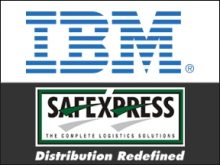 With an aim to remodel its core business processes and further expedite the adoption of next-generation technologies and digital-driven solutions Safexpress then collaborated with IBM to design and build ‘PROPEL-i’, an innovative scalable logistics platform, deployed in a secure & resilient cloud environment. The digital platform enables the company to attain agility in demand management, obtain advanced and flexible dynamic pricing modelling capabilities and provides enhanced visibility and transparency for its customers. Commenting on the collaboration, Kapil Mahajan, Group CIO, Safexpress said, “Being a technology driven organization, our next wave of business strategy was focused on building a cognitive enterprise that can keep up with the speed of transformation around us. ‘PROPEL-i’, which is our new transportation management system (TMS) platform, has been built with Design Thinking at its core and centered around 4 key pillars: People, Process, Data and Technology. Its micro services based cloud native architecture will further strengthen our position as a market leader both from logistics and technology standpoint and help us respond exceptionally faster to the market dynamics while minimising time, cost and effort on new product development lifecycle.”
With an aim to remodel its core business processes and further expedite the adoption of next-generation technologies and digital-driven solutions Safexpress then collaborated with IBM to design and build ‘PROPEL-i’, an innovative scalable logistics platform, deployed in a secure & resilient cloud environment. The digital platform enables the company to attain agility in demand management, obtain advanced and flexible dynamic pricing modelling capabilities and provides enhanced visibility and transparency for its customers. Commenting on the collaboration, Kapil Mahajan, Group CIO, Safexpress said, “Being a technology driven organization, our next wave of business strategy was focused on building a cognitive enterprise that can keep up with the speed of transformation around us. ‘PROPEL-i’, which is our new transportation management system (TMS) platform, has been built with Design Thinking at its core and centered around 4 key pillars: People, Process, Data and Technology. Its micro services based cloud native architecture will further strengthen our position as a market leader both from logistics and technology standpoint and help us respond exceptionally faster to the market dynamics while minimising time, cost and effort on new product development lifecycle.”
Kamal Singhani, Country Managing Partner, IBM Services, India/South Asia adds, “PROPEL-i is a major milestone for Safexpress as well as India’s logistics sector and is a testament to the continued success of the company’s longstanding association with IBM. By leveraging our deep industry expertise and access to technological innovations including cloud & AI, Safexpress will be able to leverage the new digital platform to manage their growing business, enrich customer experiences as well as boost revenues by acquiring new accounts & by optimizing costs.”
‘PROPEL-i’ is an internal logistics operations management suite of applications custom-built by IBM Global Business Services for Safexpress. It is designed specifically with a mobile first policy which enables the field staff to work from anywhere and frees the company to migrate to a desktop-free environment which maximizes office space.
The platform is based on microservices which is a cloud native architectural approach in which a single application is composed of many loosely coupled and independently deployable smaller components, or services. These components can be scaled and updated independently of one another, reducing the waste and cost associated with having to scale entire applications because a single feature might be facing too much load.
 Cargo Breaking News
Cargo Breaking News


